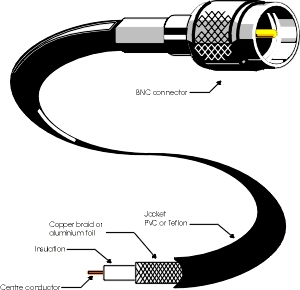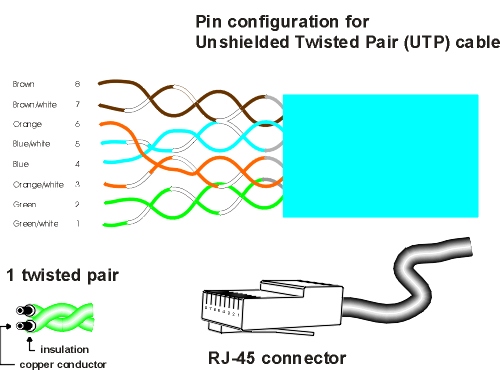Network Online Course
Lesson 3 - The Physical Network
B. Cable types
Cable types
- Coaxial cable
- Twisted pair
- Fiber optic cable
Each network allows some flexibility in choosing cable. For example, Ethernet supports coaxial cable, UTP or fiber optic. Token Ring , on the other hand, supports UTP, STP and fiber optic cable. It is up to the network designer to decide which of these cables to choose.
Many factors affect this decision including the length of the cable runs, throughput of the network, possible interference and security needs. In the following pages, you will examine the cable types along these parameters and at the end, decide for yourself which cable type is appropriate in various situations.
Coaxial cable
Coaxial cable was the first major cable used for Local Area Networks. The cable was already extensively used in mainframe systems and its characteristics made it ideal for early LANs. It has now fallen out of favor and is being replaced with cable that is more flexible and less expensive, such as unshielded twisted pair or by cable which can offer greater distances or more capacity such as fiber optic cable.
Figure 19: Coaxial cable
Construction
Coaxial cable is composed of a center conductor, either solid or stranded, copper or maybe
aluminum. Surrounding it is an insulation, called the dielectric. It is normally foam. Around
the dielectric is a copper wire mesh or aluminum foil, which is the second conductor. This
layer also give the wire some protection from interference. Finally, there is a covering
called the cladding. It may be made from PVC (PolyVinyl Chloride) or Teflon.
Coaxial cable varieties
Ethernet has two kinds of coaxial cable available. Thinnet is less expensive, hence its nickname “cheapernet”, easier to work with and install. Thicknet has a larger diameter, is very expensive and hard to work with. However, it has much greater resistance to interference and can extend to a 500 meter distance. Thinnet has a maximum length of 185 M.Pros and cons
Coaxial cable can go longer distances and has better protection from EMI than twisted pair.
On the negative side, it is harder to work with and does not lend itself to the modern
practice of running cable from every office to a central location, usually the wiring closet.
Nevertheless, when you need to go just that extra distance, coax may solve the problem and it
does a good job of connecting networks on different floors together.
Twisted Pair Cable
- Standard cable used for LANS
- Various grades, called categories, determine bandwidth
- Shielded twisted pair no longer common
- Conductors must be placed in correct order by colour
Twisted Pair cable
The most popular network cable is twisted pair. It developed from the cable used in telephone systems. That cable, however, wasn’t twisted, nor did it need to be because voice signals traveled along it fine. When early developers attempted to put digital signals on it, it was deemed a failure because of the crosstalk. Twisting the conductors around each other alleviated the crosstalk and the modern twisted pair data cable was born. Early unshielded twisted pair (UTP) cable was restricted to low throughput networks such as ARCnet and 4Mbps Token Ring. There was despair that high speed networks could ever use UTP. With advances in quality construction and by increasing the number of twists per foot, UTP can now successfully be used for networks with throughput as high as 1Gbps.Construction
Each conductor is composed of a copper core, either solid or stranded, surrounded by an
insulating sheath. Two of these conductors are twisted about each other to form a twisted pair.
A varied number of pairs are bundled together to make the final cable. Modern LANs have
standardized on a four pair cable.

Figure 20: UTP cable
Shielded or unshielded
Twisted pair cable is available in two varieties, shielded or unshielded. Shielded twisted pair (STP) cable has a shield made of copper braid, aluminum braid or aluminum foil surrounding the inner conductors. This gives it much greater resistance to electrical interference than unshielded twisted pair (UTP) cable. STP can go three times the distance of UTP because of this characteristic. Unfortunately, STP, like coaxial cable, is much heavier than UTP and is harder to work with. More to the point, it has a difference impedance than UTP and therefore cannot be substituted without making special provisions. Ethernet uses UTP while Token Ring can use either.
Plenum or patch cable
The plenum is the space above a dropped down ceiling in a modern building. It is the natural
space in which to run cabling between rooms. UTP plenum cable is stiff and holds its shape
when bent. The construction of the cable is the reason. It uses a solid, copper core for
each conductor. This type of cable would break if handled excessively, which is the case for
patch cables. These are used to connect the computer to the wall plates in a room and are
expected to be flexed many times in their life. Patch cables use stranded copper wire as their
conductors. Therefore always use the correct cabling for the job: patch cables to attach
computers to the wall, plenum cable for the interior of walls and ceilings.
Originally, there was no standard for twisted pair cables used for data transmission. However, when IBM designed their Token Ring network, they also created specifications for the cable which would be used. Enough cables were specified so that all important wiring conditions would be met. These included shielded and non-shielded cable, patch cables and cables for both the plenum (in the ceiling) as well as under carpet. These cable types are summarized in the following table. Subsequently, the Electrical Industry Association and the Telephone Industry Association (EIA/TIA) codified the specifications for UTP into categories called the EIA/TIA 568 Commercial Building Wiring Standard. The most modern practice is to wire buildings with category 5 (Cat 5e) UTP cable which is suitable for transmission up to 100Mbps.
American Wire Gauge (AWG)
When reading specifications, you will often run across the term AWG. This represents the
thickness of the metal conductor. Smaller numbers represent thicker wire. Telephone wire is
typically 22 AWG, 14 is thicker, 26 is thinner.
| Cable Chart | ||
|---|---|---|
| . | Impedance | Used By |
